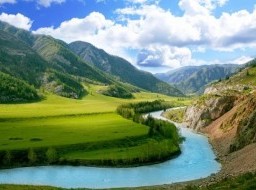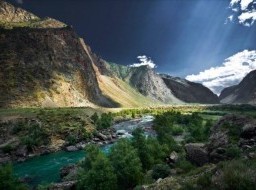Petroglyphs Kalbak-Tash
The ancient sanctuary of Kalbak-Tash is only 30 km away from our complex. Translating from Altai language it’s meaning is “ flat stone”. The unique archaeological monument of the Altai Republic was hidden from people until the beginning of the 20th century. It remained unnoticed mostly because the old road was passing above the modern part of the Chuysk tract, and the rock paintings were situated lower, near the steep cliffs of the Chui River. The monument was opened only in 1912. Petroglyphs of Kalbak-Tash (carved rock images) can be divided into several epochs. The Neolithic Age (6-4 thousand years BC) usually distinguished with the images of large figures of animals such as deer and goats, camels. The era of Eneolithic-bronze (3-1 thousand years BC), which is the largest group of drawings presented in Kalbak-Tash is marked with drawings of male and female figures, chariots and carts that are yoked with bulls, drovers and warriors, fantastic predators and domestic animals. One of the fantastic predators that emerged during this era is so-called “Altaic chimera”. Scythian epoch (VIII-III centuries BC) usually have petroglyphs with scenes of deer hunting, as well as numerous animals – goats, wolves, dogs, cat predators, marals. Ancient Turkic era (VII-X century BC) is full of hunting scenes, interesting images of wild bulls and bears. This period also includes the ancient Türkic runic inscriptions. Today complex Kalbal-Tash has around 5 thousand cave paintings. Thousands of drawings of figures of animals, people, hunting scenes were made on the slabs of a rocky hill. Large figures of deer and goats are presented on most of the Neolithic petroglyphs. The biggest group of drawings refers to the era of the Eneolithic-Bronze Age; here are stylized images of women (often next to the beast), chariots, bulls, drovers and warriors, fantastic predators and pets. Petroglyphs of Scythian time depict scenes of hunting deer, numerous animals – marals, goats, feline predators, wolves, dogs. Petroglyphs of the ancient Turkic era present images of wild bulls and bears as well as pictures of hunting. One of the most interesting imaginary is the group of “tailed” people who have semi-circular formations on their heads. Among them stands a giant with a square drawn on his chest, which could represent the receptacle of the soul. Above the “tailed people” one could notice a huge beast with a mouth full of teeth. There are several beliefs and stories about what this image represent. According to one version, this monster is seen as the absorber of souls, who cleanse them from filth before entering the higher world. This storyline is based on the believes of the Altai culture of that period. Another story that this imaginary holds is the dedication of young men to male warriors. Among the anthropomorphic, zoomorphic and solar images one can find drawings of flying saucers, aliens and spaceships, which leaves open the question whether our ancestors witnessed the visits of extra-terrestrial civilizations, or it is something that was generated by the imagination of an ancient artist. Interestingly, many of such drawings depicting fantastic animals were found throughout central Asia, in Pakistan, Mongolia. This is due to the common worldview of ancient people and similarity in their religions. |








